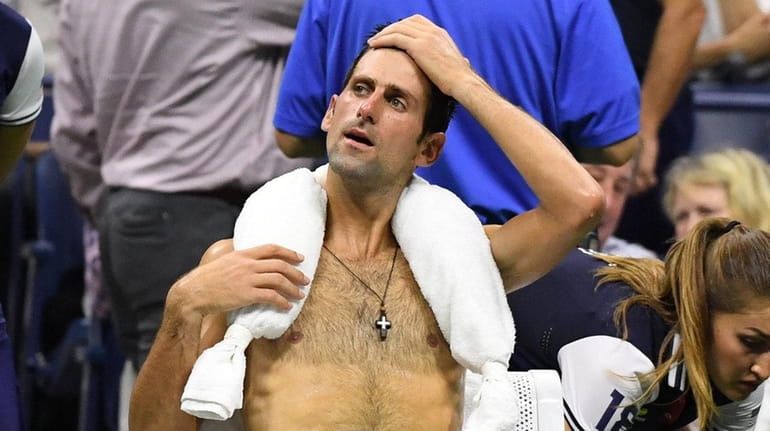Heat is on at the Open

Novak Djokovic sits with an ice towel around his neck while John Millman if off the court to change his clothes and shoes during a quarterfinal round of the U.S. Open tennis tournament at the USTA Billie Jean King National Tennis Center on Wednesday, Sept. 5, 2018. Credit: Kathleen Malone-Van Dyke
For the U.S. Open’s final weekend, the weather crisis passed. But not before tournament officials got an earful from profusely sweating players gasping to catch their breath, especially in the humid stillness of Arthur Ashe Stadium.
There were other heat-related issues as the Open played out, with an emergency “excessive heat policy” repeatedly invoked to allow brief player breaks mid-match and to have junior competition suspended during the hottest part of several days on outer courts. But the unusually uncomfortable conditions particularly highlighted how the superstructure for Ashe’s two-year-old retractable roof blocks air flow into that primary show court.
“I asked the chair umpire whether they are using some form of ventilation or air conditioning down on the court level, and he said he was not aware of that,” Novak Djokovic said after his quarterfinal match in Ashe. “I think this tournament needs to address this. It feels like a sauna.”
Now, going forward, there is the question of whether such frying-pan-to-fire heat is the new normal. And whether there need be such cold calculations as changing the Open’s commitment to only close the roof over Ashe, which triggers its air-conditioning system, in the case of rain.
The Australian Open, the first Grand Slam tournament to have a roof — completed in 1988 — closes the roof against heat and rain. The U.S. Open, when the Ashe roof was completed two years ago, determined it would only be used on rainy days, as a way to stay on schedule — such as was done for Saturday’s women’s final. That, Open director Dave Brewer said last week, is because “we are an outdoor tournament.”
But Danny Zausner, the Billie Jean King National Tennis Center chief executive officer, noted that all matters involving the facility will be under review in the usual post-Open evaluation by tennis officials, architects and engineers.
“I don’t think we can grow as a tournament and consider ourselves to be the most innovative event out there,” Zausner said, “if we don’t challenge ourselves each year to figure out what we can do to make it better.”
With the debut of the new Louis Armstrong Stadium this year, marking the completion of a five-year, $600-million transformation of the tennis center, the Open got the world’s first naturally ventilated roofed stadium. And it worked, certainly in contrast to the stuffiness in Ashe.
Zausner reminded that the design to put a roof on the then 19-year-old Ashe was done “with the intent for Ashe to also use natural ventilation. But the engineers quickly determined there was no way to get enough air flow into that existing stadium. There’s just not enough openings or locations where we could put in duct work. We would literally have been tearing the whole building apart.”
He also noted that, in 2015, “before the [Ashe] roof was even finished” but the superstructure was in place, “players such as Serena [Williams] and Roger [Federer] were saying they were so appreciative of the fact that there was so much less wind” on the court.
Now, there are small devices at the umpire chairs in both Ashe and Armstrong gauging the difference in air flow between the two and a team of engineers and architects are on site throughout the Open. And small fans have been provided, near the umpire’s chair, to cool the players a bit during changeovers — part of the “real time” adjustments Zausner said always are necessary during the two-week tournament.
Ad hoc air-conditioned rooms were set up in oversized electric closets near the field courts for players to cool off mid-match during excessive-heat policy timeouts.
“We certainly hear the players,” Zausner said. “and we’re going to, as we do in every year’s tournament, react to things that we can in real time. Already, from the first day of [qualifying tournament], I was making my list of things for next year. Things to work on.
“We also recognize that people think climate change means extreme heat, but that climate change means radical shifts. Last year was the coolest Open we’ve had. So you really have to be prepared for everything.”
